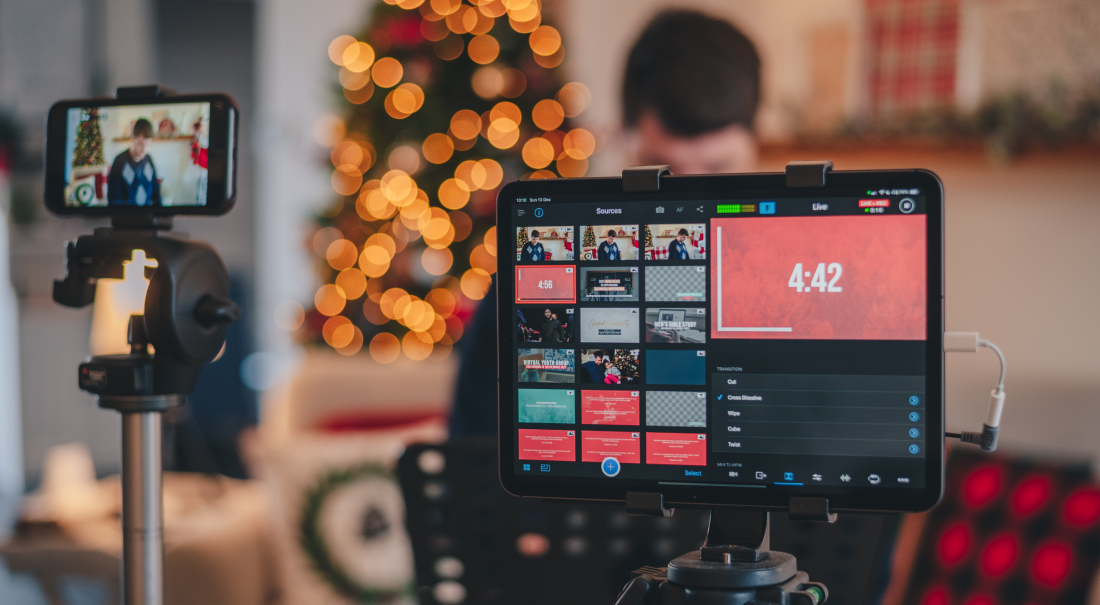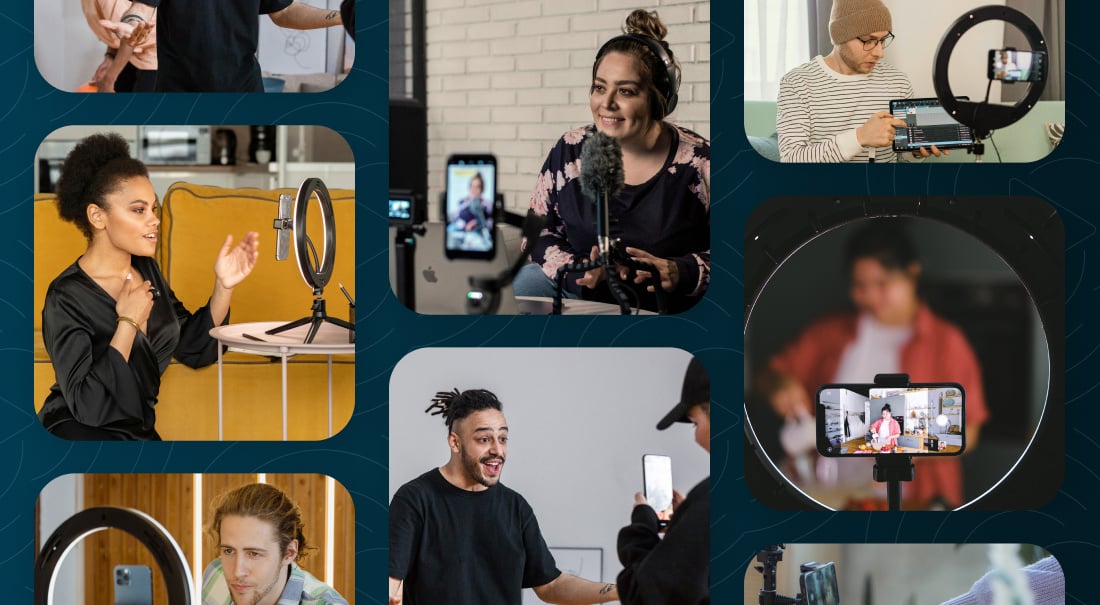
You can learn a lot about a person from their search history — like where they live, what their interests are, and what kinds of problems they’re trying to solve on any given day. I, for instance, have been searching for fingerless gloves today. This reveals a problem I’m trying to solve: My fingers feel like ice, but I need them to type.
Your audience also has problems, problems that you or your organization can solve through products, services, education, offerings, or whatever it is that you create and share with the world. And, like me, your audience members are searching the internet for solutions. Ensuring that they find you — and that they find you helpful — is what content strategy is all about.
.jpg?width=300&name=woman-with-laptop-on-couch_925x%20(1).jpg)
To this point, content strategy education has largely majored in written content and minored in a smattering of complementary media like infographics and video. But video — and live video in particular — is growing in popularity due to its unbeatable engagement and conversion rates. New York Magazine even reported that 80% of audiences would rather watch a video from a brand than read a blog post. Video is now a fundamental medium in any content strategy (if not the primary medium), which is why this series will focus on live video content strategy specifically.
What exactly is content strategy, and how do I use it for live video?
At its core, content strategy is content creation to achieve business goals. It’s not content for the sake of content. It’s not publishing a video twice a week because you’ve heard it’s good to publish twice a week. If you don’t have something worthwhile to share, producing content for its own sake is a waste of your time. Content strategy entails creating content about specific topics, to help specific audiences, with the specific goal(s) of generating traffic, leads, or revenue (or if you’re not in a revenue-focused organization, to drive another measurable success metric like donations, attendance, sign-ups, etc.).
.jpg?width=300&name=blank-notepad-on-a-desk_925x%20(1).jpg)
Live video content strategy, therefore, entails planning and producing live videos that serve your audience while also helping you achieve specific goals for your organization. When executed well, this yields win-win results for you and your audience. They’re helped by the information you provide in your videos, and you gain traffic, leads, and sales through organic and social (i.e. free) traffic generated by those videos.
Best of all, your live video content lives on long after you stop streaming. When you focus on producing helpful or problem-solving content, your videos will continue to generate traffic as evergreen resources. (And let it be known that entertaining content can absolutely fall under “helpful or problem-solving.” It’s possible that the problem you’re trying to help your audience solve is that they’re bored, tired, or looking for a little relaxation or distraction. Purely entertaining content is still helpful and still merits a content strategy.)
What are the steps involved in creating a live video content strategy?
It’s one thing to say live video content strategy entails planning and producing videos, serving your audiences, and achieving your goals. It’s another thing to actually plan and produce those videos, to know your audience, to identify your goals, and to have any idea how to measure your success. But creating your strategy doesn’t have to be difficult or overwhelming. By breaking content strategy into its successive steps and tackling them one at a time, you can identify and create your strategy relatively easily. Here’s a high-level overview of the components and steps included in a live video content strategy. We’ll break down each step in more detail in this Live Video Content Strategy blog series, walking you through how to create your own. (Be sure to subscribe to get those posts emailed right to you.)
1. Define the business goals for your live video content.
What exactly do you want your content to do for you or your organization? What business goals do you want it to help you achieve? The goals you identify need to follow the S.M.A.R.T. template: specific, measurable, attainable, relevant, and timely. Think “generate X number of leads by X date” rather than “establish us as the industry expert.” (Becoming an industry expert can be a consequence of great content, but it’s harder to measure.) Business goals don’t have to be business-y at all, of course. A nonprofit could use livestreaming to build their donor list, or an influencer could use it to grow their followers in order to land better sponsors. These are still measurable, and they point toward fundamental goals of the organization or person.
2. Identify the audience for your organization and your live videos.
Your audience is your customers or potential customers — the people with the problem that you, your organization, or your product solves. But to speak to them in a compelling way, you should understand much more about them. It helps to identify demographic information like age, location, and income level and psychographic information like attitudes, values, and behavior.
You likely have multiple types of audience members, a.k.a. personas, interested in the same product (or service or information) — like Baby Boomers buying mom jeans because that’s what they’ve always bought and Gen Zers buying mom jeans because mom jeans are hip now. Market research and persona building can help you understand the many dimensions and types of your audience members. It can also help you identify not only their problems but also the typical path they follow as they go from just becoming aware of their challenges to actually considering your offerings.
3. Identify your live video content niche.
What’s unique about your offering and/or the information you can provide? Alternately, what aspect of your audience’s topic of interest has not been covered yet, covered well, or covered thoroughly? Once you’ve identified your audience and their interests (in the last step), you can answer these questions and carve out the niche for your live videos.
4. Choose topics and generate live video ideas.
When you know your niche, your audience (and the personas within it), their interests, and their typical path, it’s usually not hard to identify the primary topics you should cover. And owning a niche often means covering the same topics repeatedly, in greater detail and from more angles.
In this step, you’ll identify your main topic categories and subtopics as well as the order in which it would make the most sense to create and release videos on different aspects of these topics. Often, planning content also involves identifying your FAQs and making plans to answer them. At this stage, you’ll also identify the team members, support, or resources you’ll need to produce the videos you’re envisioning.
5. Choose channels for your live videos.
.jpg?width=300&name=social-media-on-cell-phone_925x%20(2).jpg)
There are dozens of channels available for live video — Facebook and YouTube being chief among them. Before you start creating and releasing content, you should consider your audience, any existing following you have, and the pros and cons of each platform. With this information in mind, you'll choose where to release, host, and promote your live videos. (This may be multiple platforms or locations.)
6. Create a live video content calendar.
To be useful, plans must have a timeline. Once you’ve identified your topics, their order, and the resources that you need to create your videos, you’ll put these plans into calendar form. This calendar will be your content bible — telling you when to prep and stream each video in order to stay on track with your goals.
7. Determine how you’ll evaluate your live videos' effectiveness.
Depending on the live video channel you choose, you’ll likely have access to extensive data about your videos’ performance — view count, subscribers, shares, click-through rates, etc. All of this can be useful information that helps you determine how to replicate or improve your success. Some of these metrics, however, will be more important than others, and which ones are which will depend on the business goals you identified at the beginning. Before you produce videos, you should identify how you’ll later determine whether those videos succeeded in helping you reach your business goals. Traffic, tracking, and conversion rates will be key for most goals.
Executing and optimizing your live video content strategy
Once you’ve developed and documented your strategy, it will be time to create your videos. This will involve more than just your new strategy — there will also be some technical know-how involved, which we’ll be covering in our Live Video Technical How-Tos blog series, launching later this week.
Subscribe to the Switcher Studio blog to get those posts sent right to your inbox along with this Live Video Content Strategy series. In addition to walking you through each of the steps above, the strategy series will cover strategic components that don’t fall into the content strategy itself but are necessary for making your videos as effective as possible. These topics and more are on the docket:
- Optimizing your live videos for findability
- Promoting your videos both before and after you stream
- Choosing complementary media
- Building your live video audience
- Choosing and using CTAs for your live videos
- Generating revenue with live videos
- Engaging with your live video audience
Subscribe to the blog to ensure you get these, and follow us on Facebook to watch our own weekly live video show, #StreamSquad. If there are more topics you’d like us to cover in our strategy series or our technical series, please let us know in the comments.
Subscribe to the blog
Sign up to receive notifications whenever a new blog post is published. You may unsubscribe at any time.

Share
About the Author

As Switcher's content strategy manager, Kate strives to answer the questions of new and expert livestreamers alike. She has spent her career in digital marketing and content strategy and now funnels that experience into helping others plan and create their own video content.
All posts by Kate Brannen Smith


